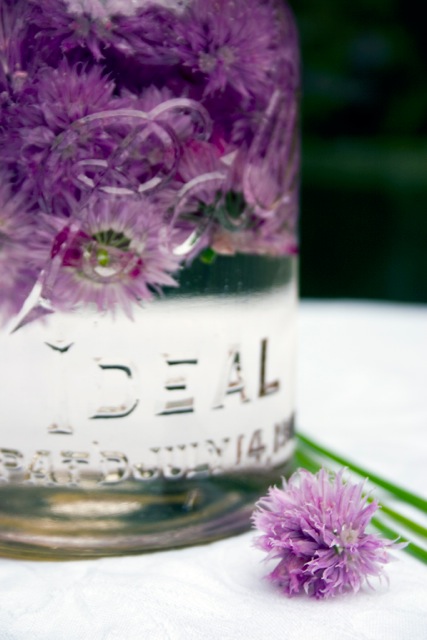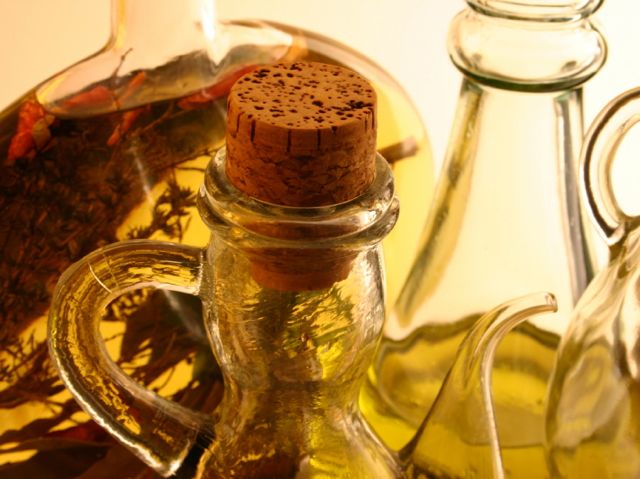
chive, l
(article, Jackie Varriano)
[%adInjectionSettings noInject=true][%pageBreakSettings nobreak=true] Sometimes, when you have the freshest of lettuces, delicately dressed with your hands and speared with a fork, there's a moment when your mouth and nose tingle deliciously, and you think, "This is the best salad I've ever had." That zingy sensation doesn't come from the tender lettuce or the grassy olive oil or the flaky salt and freshly ground pepper or even the zesty mustard you might've added to the dressing. No. It comes from the vinegar. [[block(sidebar). h1.Featured recipes]] We overlook vinegar far too often. The very act of forgetting, in fact, is probably what led someone way back when — in, say, Babylonian times — to discover vinegar. If you forget about an open jug of wine for long enough, after all, chances are it will turn into vinegar. Today, nearly every household in the Western world has a bottle of vinegar stashed away somewhere, just like that forgotten jug of wine. And we tend to take it about as seriously. As a friend of mine once blurted, "I didn’t know there were differences in red-wine vinegar." I had been extolling to her the virtues of Luigi’s Pride, a red-wine vinegar produced by Kirigin Cellars in Gilroy, California. Luigi’s Pride is a muddy red color, with a softer, rounder flavor than the normal bottle of Regina I keep on hand. [%image reference-image float=right width=400 caption="Bottle your own vinegar."] Your local supermarket probably carries several dozen varieties of vinegar, both wine-based and not (such as the rice-based vinegars essential in Asian cuisine). But you don't have to confine yourself to the store shelves. You can buy artisanal vinegars at farmers' markets, wineries, and restaurants. And it's relatively easy to make wine-based vinegar yourself, with any wine you prefer. "The wine I use is better than any wine that anyone would make to use commercial vinegar," says Gail Monaghan, a Manhattan-based cooking expert. "People say my salads are the best, and I think it’s because of the vinegar." Monaghan has been making her own vinegar for well over a decade. Her homemade efforts began when she found some vinegar mother left in a bottle of French red-wine vinegar. "I thought, 'Oh, what is this? I bet if I put wine with this mother, it will turn into vinegar.' That’s how I did it the first time," she recalls. "It was completely haphazard, and if it hadn’t have worked, I’m sure I just would’ve thrown it out and never thought about it again." Erin Coopey, a Seattle-based chef who goes by the moniker The Glorified HomeChef, decided to start making her own vinegar after reading one of French chef Jacques Pépin’s cookbooks. “I had done flavored and infused vinegars, but I was really inspired by a book that Jacques Pepin put out a few years ago that talked about how his family always had a crock of vinegar going because they would have wine," says Coopey. "And I just thought, 'Why wouldn’t I be using my leftover wine to do this?'" According to Coopey, homemade wine vinegar is entirely different from commercial versions. “There is a sweet nose, and you can actually smell the original wine,” she says. [[block(sidebar). h1. Erin Coopey's vinegar tips [[block(smalltext). Don't break the bank buying wine, but choose a wine you would be happy drinking. If you don't like the wine, you won't like the vinegar. Choose a ripe, fruity red wine, such as zinfandel or merlot. The fruit undertones provide more complexity in the vinegar. Try to ferment your vinegar in a crock. Vinegar likes warmth and air, but not light, which slows down the transformation process. If you use a glass jar, store it in a cupboard or in a snug cardboard box to cut down on the light exposure. To keep fruit flies away, place a fresh bay leaf on top of your cheesecloth-covered crock. As it dries, replace it with a fresh leaf. Try to keep your vinegar between 60 and 85 degrees. The bacteria like warmth, and the wine will transform more quickly if you maintain that temperature range. Try not to disturb the mother when feeding the vinegar. Move the mother gently aside, or use a turkey baster as a long funnel slipped down along the edge of the container. Always use a plastic spoon to taste-test your vinegar. A metal spoon can give an off taste. ]] ]] To make your own vinegar, you need some vinegar mother. You can purchase a vinegar mother online or at a local fermentation shop, or you can just buy a bottle of raw vinegar, such as Bragg's raw apple-cider vinegar or Eden's raw red-wine vinegar. Put the mother, or some of the unfiltered raw vinegar, into a big glass jar or crock. Add wine, cover with cheesecloth, store in a dark place, and wait. Coopey likes to use a fruity wine, such as zinfandel, for her vinegar. “I’ve also made them from pinot noirs, which are definitely a little more delicate, and I think you need a little bit of structure," she says. "You don’t have to be a purist when making vinegar. Some people will mix red and white together and just call it one vinegar, but you can just have a crock for red and a crock for white." Monaghan's vinegar-making is more casual. She's cultivated both white and red vinegar mothers, and just slips a piece of the appropriate mother into an open wine bottle. “I add wine as I have it," she explains. "I always keep a red one going and a white one going, and once the bottle is full, I put cheesecloth over it and forget about it." The vinegarization process usually takes a few months. “You can get a red-wine vinegar to ferment and pretty much be where you want it to be within two to three months, depending on how warm it is,” says Coopey. The easiest way to do it is to date the bottle or jar, and test it after a month. Once the vinegar has achieved the flavor you want, remove the cheesecloth and cap the bottle — or don’t. “I’m learning the vinegar seems to be better if you don’t just put a lid on it as soon as it’s ready,” says Monaghan. “If you let it sit around a whole lot more, it tends to be a bit richer.” One chef looking to take things a step further is David Santos, of the New York City restaurant Louro. “I’ve literally been making wine since I was four or five years old, so I used that wine knowledge to add in vinegars," he says. "I started making all these different wines out of products I had or ordered in, and making vinegars after they had been made into wine." Although Louro has been open for less than a year, Santos has already turned such unusual raw ingredients as tomatoes and nori into wine and then further fermented them into vinegars. “Currently we have rice-wine vinegar, Shasta tangerine, tomato, Thai chile, pear, Meyer lemon, kelp, apricot, and mead," he says. "And then I’m starting beet, peach, and jasmine rice." He drizzles the resulting vinegars over a variety of dishes served in the restaurant. “The Thai chile one is so hot," he says. "And it’s so beautifully aromatic. It’s perfect to drizzle that tiny bit over a larb salad or a cold sesame noodle salad." That's the next step up from homemade: thinking beyond salad dressing to sauces, marinades, even cocktails. “I use vinegar not only in gravies and sauces, but also in soups or stews," says Coopey. "It livens the palate." p(bio). Jackie Varriano is a writer based in Eugene, Oregon. Keep up with her at SeeJackWrite.

chive, l

fish, l

reference-image, l